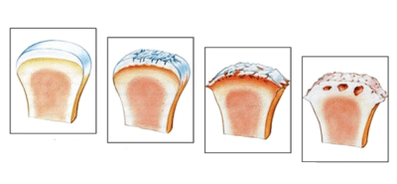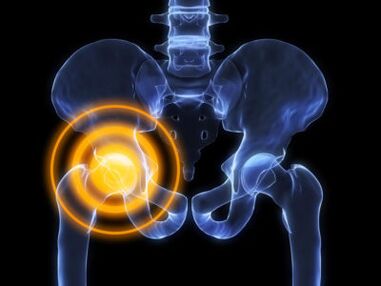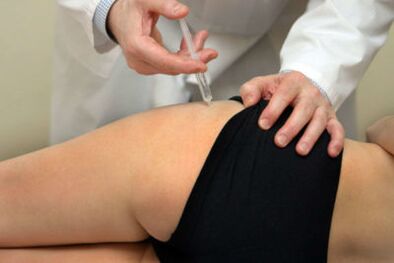The arthrosis of the hip joint is a complex disease with specific symptoms and complex treatment.The disease occurs against the background of metabolic disorders in the cartilaginous tissue of the joint cavity and the head of the femur.
The osteoarthritis of the hip joint or coksart rose occurs more often in older people.It is generally recognized that an inflammatory reaction plays the main task in the pathogenesis of the disease.According to a large number of studies, it was proven that osteoarthritis in atherosclerosis and diseases occur with metabolic disorders.
The essence of the disease
Coksartrose is an illness based on metabolic disorders with atrophic and degenerative changes in the cartilage tissue of the hip joint.
You cannot confuse osteoarthritis with arthritis.In contrast to arthritis with osteoarthritis, there is no infectious (aseptic) inflammation that has developed and progresses for many years.
Pathogenesis of development:
- Violation of metabolic processes in the cartilage.Cartilage tissue receives nutrients using the diffusion.The slightest inflammation or an edema leads to a lack of trace elements and minerals.
- Against the background of nutrient consideration processes, atrophic changes begin, cartilage tissue is refined, the amount of joint fluid and chondroblast decreases.
- Due to the madness and the destruction of the cartilage, severe pain begins.The amplitude of the movements in the joints increases.
- The cartilage is very clever, the fabulous slot narrows, the common dystrophy occurs.
Until the beginning of the dystrophy, more than a year takes place.The disease can only be stopped in the first stages, the treatment of the third stage of osteoarthritis aims treatment to reduce the symptoms and claim of the patient's life, an alternative to medication - endoprostics.
Reasons

The disease is polyetiological, there are many diseases and factors that lead to osteoarthritis or can provoke their progress.If the causes of the arthrosis of the hip joint are not determined, such a disease is referred to as idiopathic osteoarthritis.
The disease is not hereditary, but genetic pathologies in which cartilage dysplasia occurs can cause osteoarthritis of the hip joint.
The cause of the coksart rose can also be such diseases:
- Pertes syndrome - A characteristic sign of the disease is a violation of the delivery of nutrients to the cartilage tissue of the joint and thigh head.It happens in childhood, mostly boys are sick.
- Congenital transfers and subluxation of the femur.In the event of injuries, an inflammatory reaction and an aseptic melting of the cartilage tissue and the thigh head can occur.
- Necrosis of the thigh head.It occurs due to the damage to the upper artery that is attached to the top of the head.
- Rheumatoids and juvenile arthritis.Against the background of the effect of toxins or own antibodies, an exudative inflammation develops in the joint.
In view of the fact that the disease progresses slowly, the disease can be on one side and two.
There are many factors that contribute to the occurrence of osteoarthritis.They include:
- Spinal diseases (kyphosis, lordosis, scoliosis);
- Metabolic diseases of the connective tissue;
- Violation of blood supply to the joint;
- Atherosclerosis of large vessels;
- Stresses;
- Hip dysplasia;
- Congenital deformations of the lower extremities;
- Infectious diseases;
- inactive lifestyle;
- Recording of alcohol, smoking;
- older age.
Do not forget that people who deal with stretching are at great risk to develop osteoarthritis in adulthood.
One of the reasons can also be traumatic damage to the components of the connection.After the occurrence of tissue damage, an inflammatory reaction occurs, which can replace the cartilage with binding herb.
Symptoms

Due to the fact that the disease progresses slowly, the patient does not always pay attention to his first signs.It should be noted that with an early diagnosis, the likelihood of remission of the disease increases.It is very important to start treatment earlier, as it is possible to avoid the appearance of ankyloses and complete osteoarthritis.
With the arthrosis of the hip joint, symptoms can occur with different intensities, depending on the loads and the degree of the disease.
Clinical image of the arthrosis of the hip joint:
- Painful sensations that grow on severe pain on the front and lateral part of the thigh.The patients complain that the thigh hurts sharply during the curve or the load of the joint.
- The unpleasant sensations that occur when walking in the groin area are sometimes combined with pain in the thigh.
- The stiffness and restriction of the mobility of the limb in the hip joint.First the function suffers to leave aside and then everyone else.
- Unpleasant noises when walking can click or grind the joint.Constant pathological noises can be the only sign of the disease.
- Morning stiffness that comes in a few hours or before dinner.
Sometimes people ignore the possible consequences, take medication for symptomatic therapy and thereby mask the progress of the destruction process in the cartilage.
Illness
The clinical picture depends on the degree of arthrosis of the hip joint and the reactivity of the patient's body.When symptoms usually occur, changes occur in X rays.In medical practice, it is common to distinguish three radiological stages, each of which has its own properties.
The degree of arthrosis in relation to changes in x rays:
Arthrosis 1. Grade
It continues with minimal clinical manifestations, and therefore patients rarely seek help from a doctor.With an early diagnosis of the disease, the patient increases the likelihood of complete recovery.The early days of the disease is characterized by small pain in the pelvis and in the thigh.Pain increases against the background of physical exertion or walking for a long time.In the second place in relation to the frequency of the manifestation there is a symptom of the pain in the groin area.After 1 degree the pain pulls and rarely occurs.The movement volume is completely preserved.Smaller changes are made visible in an X ray.
2nd degree
In the event of a second degree, the patient begins to disrupt acute and more common pain that can occur in peace.The symptoms usually manifest themselves in the evening, and the morning stiffness only pass in dinner.In the case of longer transitions, a symptom of lameness occurs, one person cannot completely burden the diseased joint.Discomfort occurs in flexion or squats, degenerative processes progress in cartilage.Against the background of such changes, the leg can shorten, the atrophy of the hip muscles and the pelvis occurs.A narrowing of the common gap is visible in the X -rays, and a periostal reaction grows.A large number of osteophytes are in the lumen of the joint.
Final or diffuse 3. Arthrosis level
The third stage is characterized by the occurrence of motor dysfunction of the lower extremities.The patient complains about constant pain that occurs for no reason.There is a shortening of the limb by more than 5%, ankyloses occur, the joint loses the ability to mobility.The X -ray image shows the full closure of the common gap and a large number of osteophytes against the background of the bone formation.The 3rd degree treatment is only surgically.
Treatment methods

The selection of the treatment methodology depends on the degree of osteoarthritis.Comprehensive conservative treatment is used in the first stages.The second stage is the most difficult because conservative therapy is ineffective and the indications for operation are not sufficient.It is quite possible to cure osteoarthritis only with the development of the first degree of the disease.
After the diagnosis of the arthrosis of the hip joint, the doctor chooses the treatment methods.Most used:
- Conservative treatment with medication;
- Surgical treatment;
- Training therapy and massage.
Each of the treatment methods has its own characteristics, variations and specific goals.Conservative therapy is used for such purposes:
- The fight against the etiological factor.For example, metabolic or hormonal disorders can be corrected.
- Symptomatic treatment that aims to relieve the patient's life and relieve the symptoms of aliteration.For this purpose, non -steroid anti -inflammatory drugs are used.Most of the sodium diclofenac, nimesulide and ibuprofen from NSAIDS are used.
In order to get rid of constant pain, NSAIDs are taken almost every day, and this can influence the patient's stomach tract and cause the development of stomach ulcers.
Surgical intervention is displayed with the third degree of osteoarthritis and is the only method for restoring the walking function.The essence of the methodology is the complete or partial replacement of the joints of the joint by titanium endoprostheses.
Medial physical education is an essential part of all rehabilitation measures.Training therapy and massage aim to improve blood flow in the joint.Training therapy is also used to reduce the risk of ankylos.
You should be careful when executing exercises because you can damage the common osteophytes.Tactics and exercises should be selected by a doctor based on their individual characteristics and their clinical image of the disease.





















